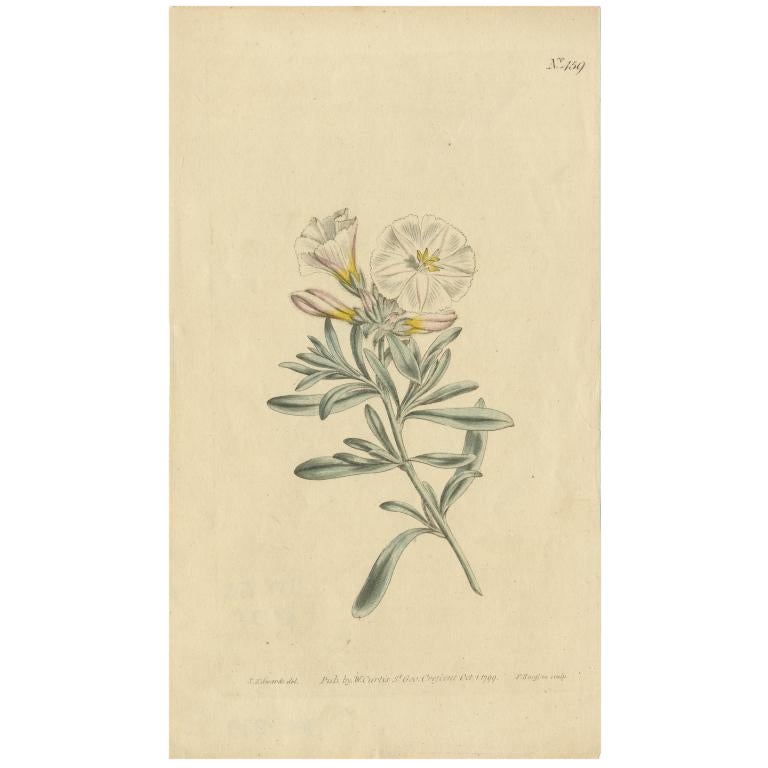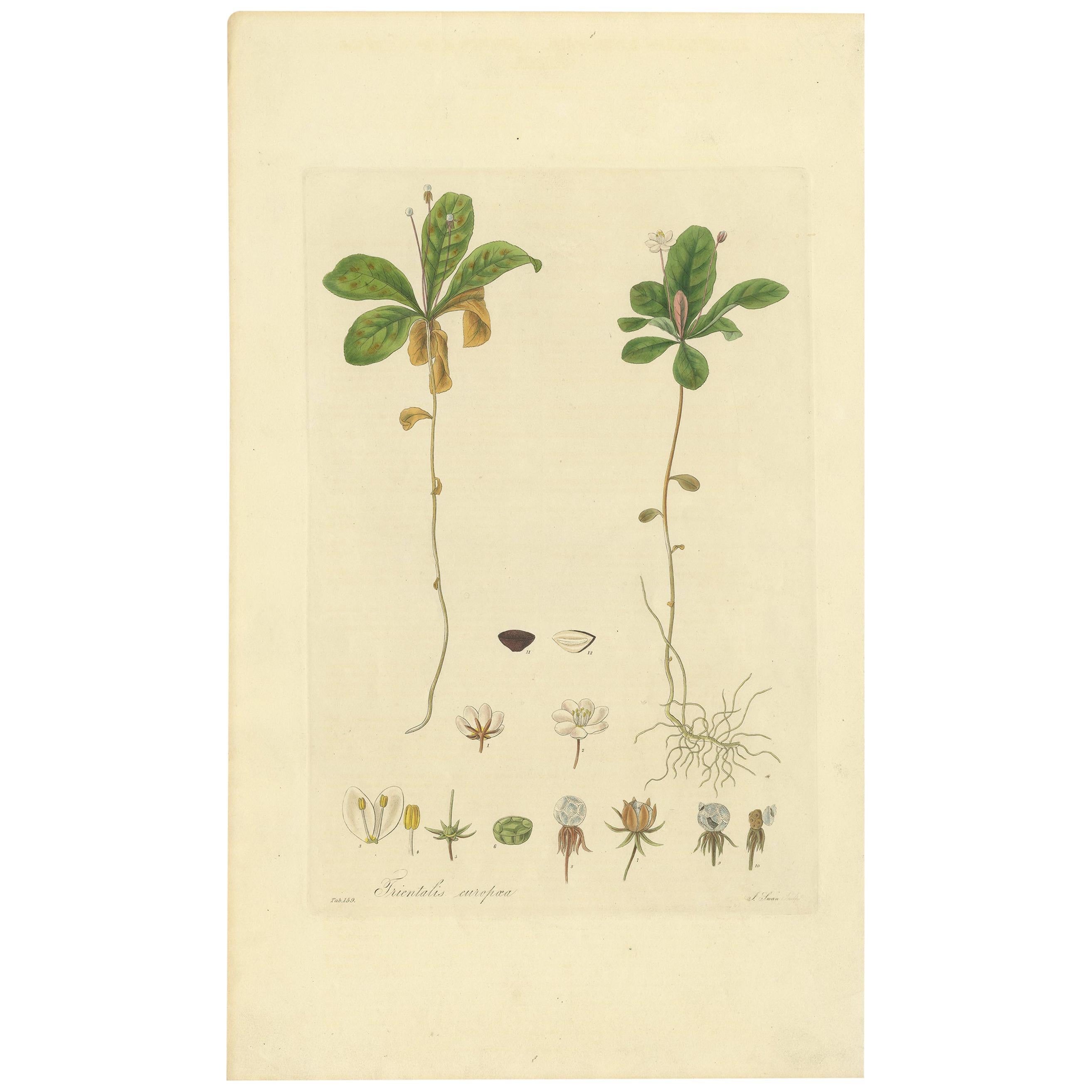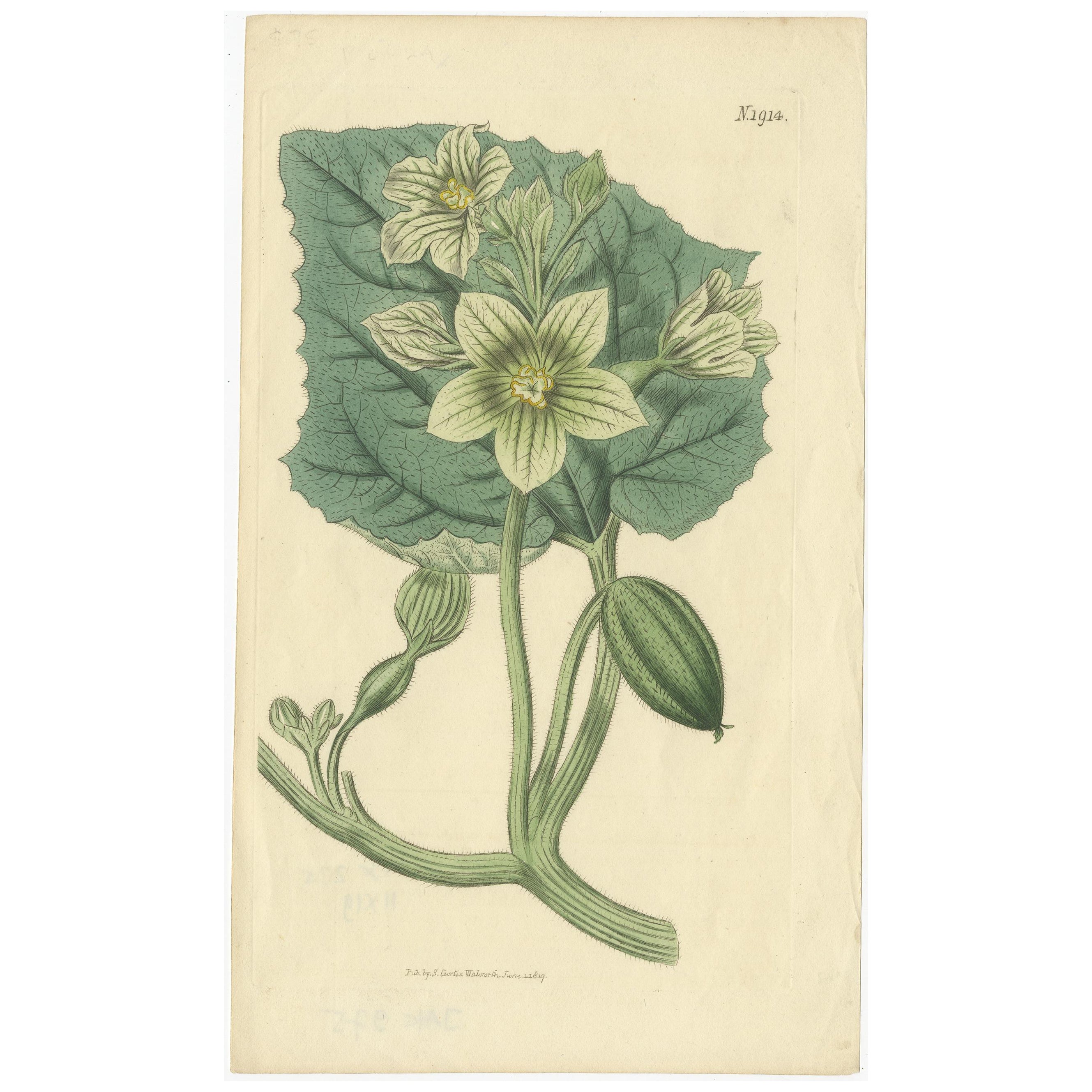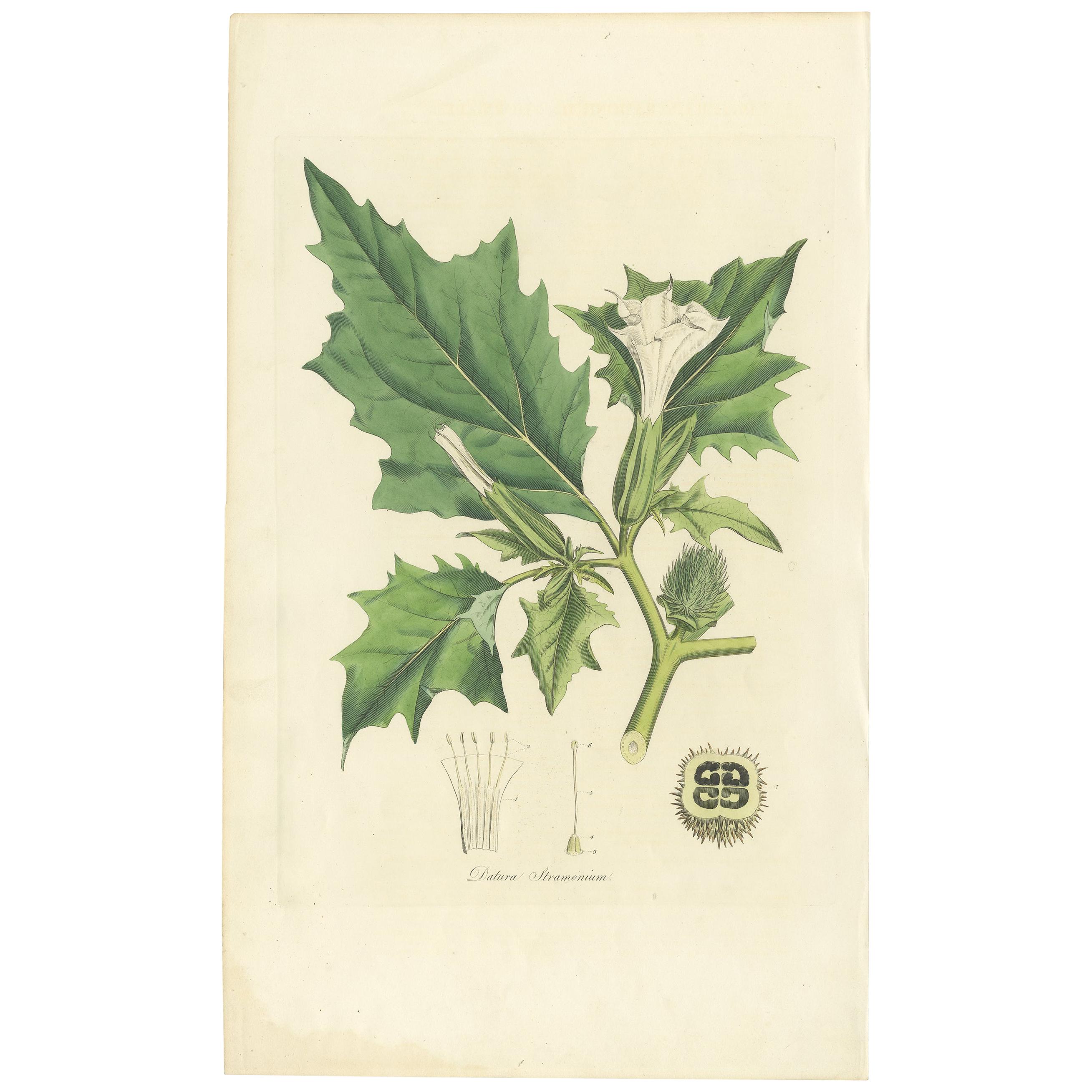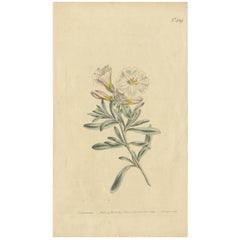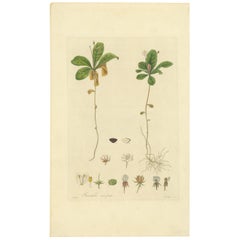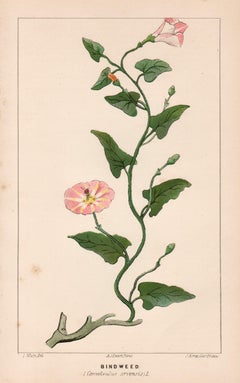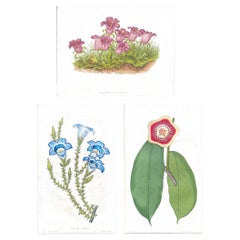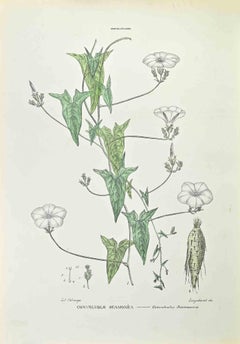Items Similar to Antique Botanical Print of Convolvulus Scammonia, or Scammony, ca.1821
Want more images or videos?
Request additional images or videos from the seller
1 of 8
Antique Botanical Print of Convolvulus Scammonia, or Scammony, ca.1821
$162.33
$202.9120% Off
£121.12
£151.4020% Off
€136
€17020% Off
CA$226.36
CA$282.9520% Off
A$248.06
A$310.0720% Off
CHF 129.54
CHF 161.9320% Off
MX$2,981
MX$3,726.2520% Off
NOK 1,619.50
NOK 2,024.3720% Off
SEK 1,527.45
SEK 1,909.3120% Off
DKK 1,035.39
DKK 1,294.2420% Off
About the Item
Antique botanical print titled 'Liseron Scammonée'. This print shows the Convolvulus Scammonia, commonly known as scammony. It is a bindweed native to the countries of the eastern part of the Mediterranean basin; it grows in bushy waste places, from Syria in the south to Crimea in the north, its range extending westward to the Greek islands, but not to northern Africa or Italy. It is a twining perennial, bearing flowers like those of Convolvulus arvensis, and having irregularly arrow-shaped leaves and a thick fleshy root. This print originates from 'Phytographie Medicale' by Joseph Roques. Engraved by Édouard Auguste Patrice Hocquart. Published circa 1821.
Édouard Auguste Patrice Hocquart (1789–1870), frequently cited as L. F. J. Hoquart, was a French publisher, writer, artist and engraver, noted for his colour plates illustrating Joseph R. Roques's (1772–1850) materia medica publication Phytographie médicale of 1821–1824.
More in detail:
The Convolvulus Scammonia, or scammony, is special for several reasons that highlight its uniqueness in the botanical world and its historical uses:
1. **Unique Habitat**: Scammony thrives in the specific climates and terrains of the eastern Mediterranean basin, from Syria to Crimea and the Greek islands. Its adaptation to bushy waste places in this particular geographic region underscores its ecological niche and specialized growth requirements.
2. **Medicinal Root**: One of the most distinguishing features of scammony is its thick, fleshy root, which has been used historically for medicinal purposes. The root contains a milky juice that, when dried, forms a gum-like substance known as scammonium. This substance has been used as a powerful purgative or laxative in traditional medicine.
3. **Twining Growth and Flowers**: Scammony is a twining perennial, which means it grows by spiraling around other plants or supports. This growth habit, combined with its flowers that resemble those of the common bindweed (Convolvulus arvensis), adds an aesthetic value to the plant. The irregularly arrow-shaped leaves further contribute to its distinctive appearance.
4. **Botanical Interest**: Its place within the Convolvulus genus, which includes a variety of species with different growth habits and ecological adaptations, makes scammony a subject of interest for botanists and plant enthusiasts. Studying its characteristics can provide insights into the diversity and evolution of plants within this genus.
5. **Historical and Cultural Significance**: The use of scammony's root in traditional medicine connects it to the cultural and historical practices of the regions where it is native. Its role in herbal medicine and the trade of medicinal plants adds layers to its significance beyond its botanical characteristics.
These aspects make the Convolvulus Scammonia a plant of interest not just for its visual beauty and ecological adaptation, but also for its historical, medicinal, and cultural significance.
- Dimensions:Height: 12.29 in (31.2 cm)Width: 8.78 in (22.3 cm)Depth: 0.02 in (0.5 mm)
- Materials and Techniques:
- Period:
- Date of Manufacture:c.1821
- Condition:Age-related toning. Shows some staining. Minor wear, blank verso. Please study image carefully.
- Seller Location:Langweer, NL
- Reference Number:Seller: BG-13584-41stDibs: LU3054338353492
About the Seller
5.0
Recognized Seller
These prestigious sellers are industry leaders and represent the highest echelon for item quality and design.
Platinum Seller
Premium sellers with a 4.7+ rating and 24-hour response times
Established in 2009
1stDibs seller since 2017
2,655 sales on 1stDibs
Typical response time: <1 hour
- ShippingRetrieving quote...Shipping from: Langweer, Netherlands
- Return Policy
Authenticity Guarantee
In the unlikely event there’s an issue with an item’s authenticity, contact us within 1 year for a full refund. DetailsMoney-Back Guarantee
If your item is not as described, is damaged in transit, or does not arrive, contact us within 7 days for a full refund. Details24-Hour Cancellation
You have a 24-hour grace period in which to reconsider your purchase, with no questions asked.Vetted Professional Sellers
Our world-class sellers must adhere to strict standards for service and quality, maintaining the integrity of our listings.Price-Match Guarantee
If you find that a seller listed the same item for a lower price elsewhere, we’ll match it.Trusted Global Delivery
Our best-in-class carrier network provides specialized shipping options worldwide, including custom delivery.More From This Seller
View AllConvolvulus Batatas Botanical Engraving - Icones Plantarum Medicinalium, 1788
Located in Langweer, NL
"Convolvulus Batatas Botanical Engraving - Icones Plantarum Medicinalium, 1788"
This delicate hand-colored engraving features the Convolvulus Batatas, also known as the Sweet Potato...
Category
Antique 1780s Prints
Materials
Paper
$276 Sale Price
20% Off
Convolvulus Jalapa Botanical Engraving - Icones Plantarum Medicinalium, 1788
Located in Langweer, NL
"Convolvulus Jalapa Botanical Engraving - Icones Plantarum Medicinalium, 1788"
Description
This hand-colored engraving presents the Convolvulus Jalapa, commonly known as the Jalap b...
Category
Antique 1780s Prints
Materials
Paper
$276 Sale Price
20% Off
Antique Botany Print of Convolvulus Cneorum by Curtis, 1799
Located in Langweer, NL
Antique botany print of Convolvulus Cneorum, also known as the silverbush or shrubby bindweed. This print originates from 'The Botanical Magazine; or Flower-Garden Displayed'.
Arti...
Category
Antique 18th Century Prints
Materials
Paper
$81 Sale Price
20% Off
Antique Botany Print of Trientalis Europea by Curtis, 'circa 1817'
Located in Langweer, NL
Antique botany print titled 'Trientalis Europaea'. Hand colored engraving of trientalis europaea, also known as chickweed-wintergreen or arctic starflower. This print originates from...
Category
Antique Early 19th Century Prints
Materials
Paper
$286 Sale Price
20% Off
Antique Botany Print of Ecballium Elaterium by Curtis, 1817
Located in Langweer, NL
Antique botany print of Ecballium Elaterium, also known as the squirting cucumber or exploding cucumber. It gets its unusual name from the fact that, when ripe, it squirts a stream o...
Category
Antique 19th Century Prints
Materials
Paper
$81 Sale Price
20% Off
Antique Botany Print of Datura Stramonium by Curtis 'circa 1817'
Located in Langweer, NL
Antique botany print titled 'Datura Stramonium'. Hand colored engraving of datura stramonium, known by the common names thorn apple, jimsonweed (jimson weed...
Category
Antique Early 19th Century Prints
Materials
Paper
$268 Sale Price
25% Off
You May Also Like
Bindweed (Convolvulus arvensis), antique botanical lithograph
Located in Melbourne, Victoria
'Bindweed (Convolvulus arvensis)'
Colour lithograph, 1909.
Category
Early 20th Century Naturalistic More Prints
Materials
Lithograph
Campanula Allionii – Original Antique Botanical Print, France, 19th Century
Located in Fukuoka, JP
Hand-colored lithograph from the 1800s
A finely detailed and richly colored 19th-century botanical print depicting Campanula Allionii, a charming alpine bellflower native to the sou...
Category
Antique 19th Century British Prints
Materials
Paper
Apocynum androsamifolium - French botanical flower engraving by Bessa, c1830
By After Pancrace Bessa
Located in Melbourne, Victoria
'Apocynum androsamifolium' (Fly-trap dogbane or spreading dogbane)
Original copper-line engraving with original hand-colouring.
From 'Herbier general de l'amateur' by Jean Louis A...
Category
Early 19th Century Naturalistic Still-life Prints
Materials
Engraving
Convolvulus Scamonea - Lithograph by Vincenzo Tenore - 1870s
Located in Roma, IT
Lithograph hand watercolored.
Belongs to the Series "Atlante di Botanica popolare ossia Illustrazione di Piante Notevoli di ogni famiglia" (Atlas of popular botany or illustration o...
Category
1870s Modern Figurative Prints
Materials
Lithograph
$167 Sale Price
30% Off
Original Antique Botanical Print, Lisianthus Princeps, circa 1835
Located in St Annes, Lancashire
Wonderful botanical print.
Lithograph by J & J Parkin and D.Hayes
After C.W Harrison
Original hand color
Published, circa 1835
Unframed.
Category
Antique 1830s English Chinoiserie Prints
Materials
Paper
Flowering Cotton Plant: 18th Century Hand-colored Weinmann Botanical Engraving
By Johann Wilhelm Weinmann
Located in Alamo, CA
This striking hand-colored botanical mezzotint and line engraving is entitled "Gnaphalium, Gossypium (Cotton Plant)". It is plate 551 in Johann Weinmann's monumental publication "Phy...
Category
Mid-18th Century Naturalistic Still-life Prints
Materials
Engraving, Mezzotint
More Ways To Browse
Antique Grinding Stone
Antique Hand Carved Chinese Bar
Antique Keyhole Cover
Antique Korean Bandaji Chest
Antique Medical Art
Antique Merchant Chest
Antique Mounted Butterflies
Antique Patent
Antique Pine Server
Antique Postal Furniture
Antique Shaving Stand Furniture
Antique Smoking Set
Antique Solingen
Antique Stable Door
Antique Staffordshire Cows
Antique Stirrup Cup
Antique Teapoy
Antique Tool Chest
